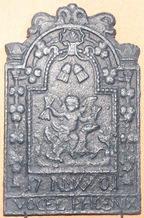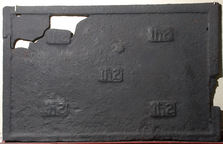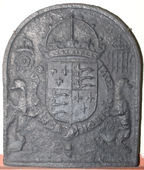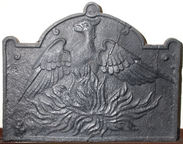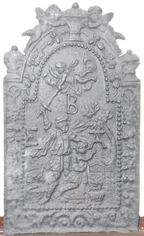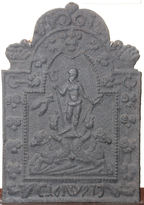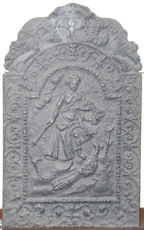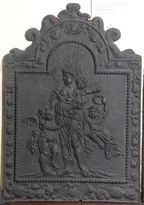-
377
Description: Arched rectangular central panel with bead on fillet edging and two tassels hanging from top of arch; pictorial image of a cherub with arrows in both hands sitting on a phoenix; arched rectangular border with fillet edging; scallop shell at top with descending ribbons and fruit clusters; date and monogram below central panel; bottom panel with inscription; on top, two sea serpents, with open buds on shoulders of recatngle.
Notes: The customary monogram on such firebacks is NDV. Several anglicised versions of this type of fireback exist. Formerly part of the J. H. Every collection.
Copies of this fireback are known.
Inscription: 17 NDW 01 / VOGEL PHOENIX [bird phoenix]
- Decoration tags:
- 'Dutch' (shape)
- fillet (edging)
- whole carved pattern
- pictorial
- mythological
- text
- humans
Manufactured: in 1701 in the Siegerland area of Germany.
Current location: Anne of Cleves House, Southover High Street, Lewes, East Sussex, England.
Museum number: 1944.24.087 (part of the Sussex Archaeological Society museum group)
- Attached to series:
- 'Dutch' NDW series
-
382
Description: Rectangular; broad fillet edging; 'IhS' stamp repeated five times (4-1-4) centrally.
Notes: The use of the christogram suggests a Catholic, and therefore a possibly pre-Reformation or Marian date.
Inscription: IhS [repeated 5 times]
- Decoration tags:
- rectangular (shape)
- fillet (edging)
- carved stamps
- text
Manufactured: in the early- to mid-16th century in the Weald area of England.
Current location: Anne of Cleves House, Southover High Street, Lewes, East Sussex, England.
Museum number: 1944.24.036 (part of the Sussex Archaeological Society museum group)
- Attached to series:
- Religious firebacks
-
397
Description: Arched; fillet edging; Tudor royal shield, garter, crown and supporters (dragon and greyhound); top left, crowned Tudor rose; top right, crowned portcullis (grid of 6).
Notes: There are several firebacks with the Tudor royal arms that were probably produced in the Spanish Netherlands, perhaps illustrating the association between England and Spain through the marriage of Henry VIII and Katherine of Aragon. The firebacks differ in several small details, such as the form and rotation of the Garter motto, the style of the crown, the positioning of the supporters in relation to the Garter, and the form and size of the crowned rose and portcullis.
Copies of this fireback are known.
Inscription: HONI SOIT QVI MAL I PENSE
Arms: Tudor royal
- Decoration tags:
- rounded arched (shape)
- fillet (edging)
- whole carved pattern
- heraldic
- armorial
- royal
- text
Manufactured: in the mid-16th century possibly in the Wallonia area of Luxemburg.
Current location: Anne of Cleves House, Southover High Street, Lewes, East Sussex, England.
Museum number: LH000.915 (part of the Sussex Archaeological Society museum group)
Citation: Lloyd, N., 1925, 'Domestic Ironwork I', Architectural Review, 58, pp. 58-67.
- Attached to series:
- Tudor royal armorial firebacks
- Continental Tudor royal armorial firebacks
-
409
Description: Quasi-arched rectangular shape, semi-circular protrusions on top corners; circular loop at top of arch; fillet edging with small twists inside arch, and curls inside and below top corners; a phoenix in flames, its wings displayed and inverted.
Notes: The use of the loop in the edging draws comparisons with other firebacks, and may indicate the same source. Formerly part of the J. H. Every collection.
- Decoration tags:
- rectangular with round arch (shape)
- fillet (edging)
- whole carved pattern
- planklines
- pictorial
- mythological
- animals
Manufactured: in the mid- to late-17th century possibly in the Weald area of England.
Current location: Anne of Cleves House, Southover High Street, Lewes, e, England.
Museum number: 1944.24.061 (part of the Sussex Archaeological Society museum group)
- Attached to series:
- Loop edged firebacks
- Phoenix firebacks
-
413
Description: Arched rectangular central panel with bead edging; standing figure of Abraham about to sacrifice a kneeling Isaac, Abraham's raised right hand holding a sword is retrained by an angel; behind Abraham is a ram; initials are placed in a triangle above behind and in front of the group; arched rectangular border with fillet edging and descending floral and fruit bunches on a ribbon, hanging from rings, foliate swirls at base; vases on rectangle shoulders and at top, between two putti
Notes: The initials appear to have been added subsequently.
Inscription: B / E A
- Decoration tags:
- 'Dutch' (shape)
- fillet (edging)
- whole carved pattern
- individual letters
- pictorial
- biblical
- text
- humans
Manufactured: in the mid- to late-17th century possibly in the Siegerland area of Germany.
Current location: Anne of Cleves House, Southover High Street, Lewes, East Sussex, England.
Museum number: LH000.946 (part of the Sussex Archaeological Society museum group)
-
414
Description: Rectangular central panel with elongated arch; bead edging; semi-nude figure of Poseidon/Neptune, a trident in his right hand, standing on two hippocampi (mythical sea horses). Rectangular border with elongated arch; fillet edging; two suspended festoons of fruit and leaves; at the bottom, the date and monogram. On top, two scrolls of foliage. On each shoulder of the fireback, a basket with fruit
Notes: A number of images of Poseidon on firebacks bear more than a passing similarity to fountain statuary. This is just such an example although the source of the design has yet to be identified. Formerly part of the J. H. Every collection.
Copies of this fireback are known.
Inscription: 16 NDW 97
- Decoration tags:
- 'Dutch' (shape)
- fillet (edging)
- whole carved pattern
- pictorial
- mythological
- monogram
- text
- animals
- humans
Manufactured: in 1697 in the Siegerland area of Germany.
Current location: Anne of Cleves House, Southover High Street, Lewes, East Sussex, England.
Museum number: 1944.24.075 (part of the Sussex Archaeological Society museum group)
- Attached to series:
- 'Dutch' NDW series
-
415
Description: Arched rectangular central panel with bead-and-pellet edging on a broad fillet; figure of Hera/Juno, a sceptre in her right hand, with a peacock below to her left, clouds above left; arched rectangular border with fillet edging; symmetrical arrangement of wire-work swirls; on top, two mirrored serpents.
Notes: Similarities in the design and execution of the pattern suggest the work of the pattern-maker identified as ‘N’. Said to have been cast by Thomas Prickett (1727-95) at Gloucester Furnace, Lamberhurst.
Copies of this fireback are known.
- Decoration tags:
- 'Dutch' (shape)
- fillet (edging)
- whole carved pattern
- pictorial
- mythological
- animals
- humans
Manufactured: in the early-18th century probably at Gloucester Furnace, Lamberhurst in the Weald area of England.
Current location: Anne of Cleves House, Southover High Street, Lewes, East Sussex, England.
Museum number: LH000.948 (part of the Sussex Archaeological Society museum group)
Citation: Dawson, C., 1903, 'Sussex Iron Work and Pottery', Sussex Archaeological Collections, 46, pp. 1-54.
- Attached to series:
- British 'Dutch' style firebacks
-
416
Description: Arched rectangular central panel with bead edging; with tassel at top; three nude female figures: on top, Juno/Hera with a peacock, to the left Venus/Aphrodite, the young cupid/Eros at her feet, to the right Minerva/Athena with spear and shield; arched rectangular border with fillet edging; the heads of two putti and from them two suspended festoons of fruit and leaves; at the bottom, the inscription, THE 3 GODDESES, widely spaced. On top, two figures of Triton blowing seashells. On each shoulder of the fireback, a fluted vase with flowers issuing.
Notes: The three eponymous goddesses are those whose beauty was the subject of the Judgement of Paris. The composition is copied from an engraving by Adriaen Collaert (c1560-1618). This fireback is an instance of a continental back which has been copied in England, the opportunity being taken to insert an English inscription in place of the customary date and pattern maker's monogram. Formerly part of the J. H. Every collection.
Copies of this fireback are known.
Inscription: THE 3 GODDESES [sic]
- Decoration tags:
- 'Dutch' (shape)
- fillet (edging)
- whole carved pattern
- pictorial
- mythological
- text
- animals
- humans
Manufactured: in the late-17th century in England.
Current location: Anne of Cleves House, Southover High Street, Lewes, East Sussex, England.
Museum number: 1944.24.074 (part of the Sussex Archaeological Society museum group)
- Attached to series:
- 'Dutch' NDW series
- Judgement of Paris firebacks
-
423
Description: Arched rectangular central panel with bead edging; standing female figure, classically dressed, holding a child in her arms, another child holding a wreath, seated to her left, and a putto standing to her right; arched rectangular border with fillet edging; mask top centre with descending floral bunches on ribbons, with a cartouche centre bottom; on top, two symmetrical descending serpents.
Notes: The figure represents Charity, one of a several iconic figures portrayed on firebacks of this period.
Copies of this fireback are known.
- Decoration tags:
- 'Dutch' (shape)
- fillet (edging)
- whole carved pattern
- pictorial
- allegorical
- humans
Manufactured: in the mid- to late-17th century in the Siegerland area of Germany.
Current location: Anne of Cleves House, Southover High Street, Lewes, East Sussex, England.
Museum number: LH000.947 (part of the Sussex Archaeological Society museum group)
- Attached to series:
- 'Dutch' Miscellaneous Firebacks
- Charity firebacks
-
424
Description: Arched rectangular central panel with bead edging terminating at the top in two loops, gather drapery and a scallop shell; two figures to the right, both bearded, the one kneeling wears cavalry armour, a cloak and a crown, the other stands behind; to the left is a sacrificial pyre on which an ox carcass burns, and above an angel carrying a sword in his right hand and a skull in his left; around this is an arched rectangular border with fillet edging and a repeated leaf pattern; on top is a scallop shell between two dolphins.
Notes: The scene illustrates the visitation of the pestilence on Israel described in 2 Samuel 24, and the sacrifice of an oxen by King David; the skull borne by the angel represents the death of those struck down by the plague. A slightly different version has the face of David looking down (no. 527). Formerly part of the J. H. Every collection.
Copies of this fireback are known.
Manufactured: in the mid- to late-17th century in the Siegerland area of Germany.
Current location: Anne of Cleves House, Southover High Street, Lewes, East Sussex, England.
Museum number: 1944.24.070 (part of the Sussex Archaeological Society museum group)
Citation: Hughes, G. B., 1960, Collecting Antiques (London, Country Life), pp. 85-93.
